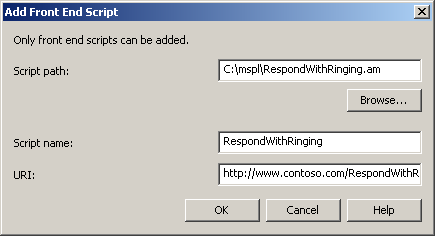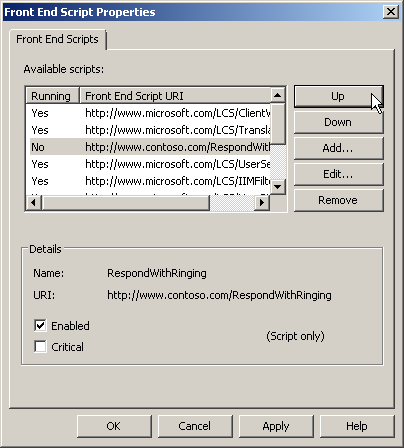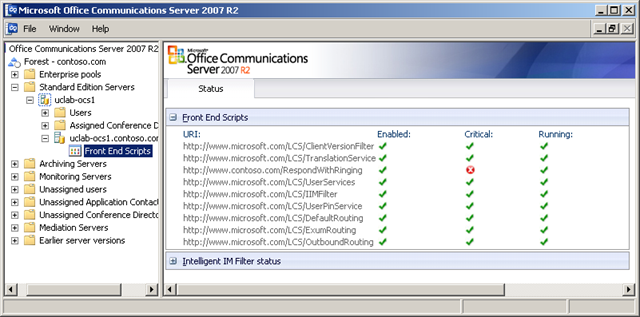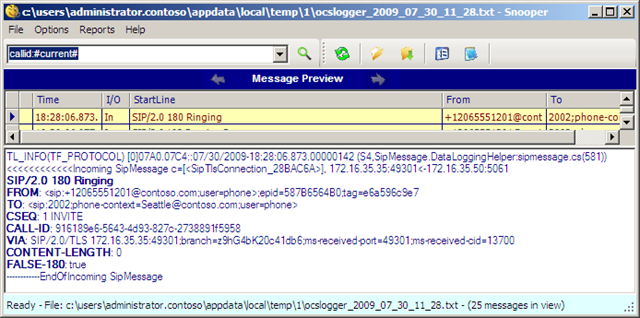Workaround for Ring Back Issues in Office Communications Server
Caveat: What follows could best be classified as a hack. I have posted this information because sometimes a hack is called for but also because it highlights the strength of OCS as a platform. Although implementing this workaround is via supported mechanisms, there is no support for the code included below. Please test in a non-production environment to ensure that this solves your problem with no other side effects.
On a particular voice deployment, we noticed an issue with PSTN callers to OCS not hearing any ring back tones (the ringing sound) in certain situations. We were able to fix the issue, though, with the creative use of the Microsoft SIP Processing Language (MSPL).
Our specific scenario was that the Communicator user had configured OCS to simultaneously ring (hereafter simply called “SimRing”) a PSTN phone number. While the user was signed into Communicator, the caller would hear ringing and SimRing would work. When the user was not signed into Communicator, the caller would not hear ringing and the call would disconnect within a few seconds before the called party could pick up the SimRing phone.
The problem occurred because of a missing “180 Ringing” SIP response message. When Communicator is signed in, it generates the ringing message and OCS routes this back to the caller appropriately. When Communicator is not signed in, it obviously does not generate this message. The endpoint that is being called through SimRing should generate it and OCS will route that back to the caller. In our case, that other endpoint was not generating it. So, to the caller, it did not look like any endpoints were ringing.
The most appropriate fix, in this case, would be to resolve why the ringing endpoint is not sending the alert appropriately. But, that would involve working with multiple vendors and resolving a complex call flow. We chose, instead, to simply generate the “180 Ringing” response for all calls inbound from the PSTN regardless of Communicator’s online status. This amounts to a little white lie. We will be telling the caller that an endpoint is ringing in some cases where none really are. (Because of the way it works, too, if Communicator is online, two ringing responses will be sent.)
The script that generates this response is pretty straightforward. It is written in MSPL and is added to the OCS front end server that is the mediation server’s next hop. Because it generates ringing responses for all inbound calls from the mediation server, it is likely to help in other situations where PSTN callers are not hearing ring back tones. To my knowledge, this script has been used without issue on both OCS 2007 and OCS 2007 R2.
The code is provided below for easy discovery and reading. To use the code, I have also provided it as an attachment to this post (RespondWithRinging.am). You can download that attachment and install it with the steps below. (Sometimes the attachment link is hard to find. Open the post and look for the attachments just before the comment section.)
To Install the Script
Select the “Front End Scripts” node that is under the OCS server that is the next hop for your mediation server. (You may need to repeat these steps for each server or pool that mediation servers use.) We will be adding this script to the list in the position just above UserServices. Right-click “Front End Scripts” and choose “Properties” to modify the list of scripts.
Click the “Add…” button to add a new script.
Complete the “Add Front End Script” dialog with the appropriate information. The script path is wherever you have saved the RespondWithRinging.am file attached to this post. The script name is an arbitrary value you can supply. The URI must match the appUri value given in the application manifest.
The script will be added to the bottom of the list. In this position, it will not be called for inbound calls because they will be handled by applications higher in the stack. You will need to use the “Up” button to move the script into the position above UserServices. There is no reason to mark this script as critical.
After applying the new front end script properties, your list of front end scripts should look like this:
With this script in place, you should be able to see the “180 Ringing” responses that are generated by it for inbound PSTN calls. Notice the “FALSE-180” header that the script inserts to let you know where this response comes from.
For reference, here are the contents of RespondWithRinging.am. (If you view this post, you can see the attachments link just before the comment area at the bottom.)
<?xml version="1.0"?>
<lc:applicationManifest
lc:appUri="www.contoso.com/RespondWithRinging"
xmlns:lc="schemas.microsoft.com/lcs/2006/05">
<lc:allowRegistrationBeforeUserServices action="true" />
<lc:requestFilter methodNames="INVITE"
strictRoute="false"
registrarGenerated="true"
domainSupported="true" />
<lc:responseFilter reasonCodes="NONE" />
<lc:proxyByDefault action="true" />
<lc:scriptOnly />
<lc:splScript><![CDATA[
// This script will respond to incoming INVITEs from
// the mediation server.
// Build the user@host from the To: header.
toUri = GetUri( sipRequest.To );
toUserAtHost = Concatenate( GetUserName( toUri ), "@", GetHostName( toUri ) );
Log( "Debug", false, "RespondWithRinging: we have a request: ", sipRequest.Method, " ", toUserAtHost );
// Check if this is a re-INVITE and exit if so
foreach ( sessionExpires in GetHeaderValues( "Session-Expires" ) ) {
if ( ContainsString( sessionExpires, "refresher", true ) ) {
Log( "Debug", false, "RespondWithRinging: * skipped; This is a session refreshing invite" );
return;
}
}
// Check to make sure that the INVITE is from a mediation server
foreach ( userAgent in GetHeaderValues( "USER-AGENT" ) ) {
if ( ! ContainsString( userAgent, "mediation", true ) ) {
Log( "Debug", false, "RespondWithRinging: * skipped; not a mediation server request" );
return;
}
}
// If we're here, send a 180 response
// Headers are being added in case it's important to detect this generated 180 response in a log
Log( "Debug", 1, "RespondWithRinging: * Ringing response being submitted" );
AddHeader( "FALSE-180", "true" );
Respond( 180, "Ringing", "FALSE-180=true" );
return;
]]></lc:splScript>
</lc:applicationManifest>
As I have mentioned, there is no support for this solution. If it feels like a kludge to you, you are right to feel that way. That said, it may be the quickest way to workaround issues of missing ring back tones while you are working to resolve the real underlying issue. If you use this script in your environment, I would appreciate you contacting me and letting me know how it’s going.
--Doug
This post has been brought to you by VoIPNorm.
Comments
Anonymous
January 01, 2003
@Aaron: I can't speak to what might be planned for future product releases. If they were to ask me, though, I'd put this one near the bottom of the wish list. This fix breaks the semantics of the 180 response and creates a standards-compliance issue much bigger than the WMI setting for removing the plus sign. In every case I've seen, it could be fairly said that this fix was covering up a problem in the connecting system rather than fixing an OCS deficiency. @brad: According to RFC3261, the 180 response indicates that the user agent "receiving the INVITE is trying to alert the user." In the case of Exchange UM, it's not true that it is alerting the user. The system answers the INVITE immediately. A 180 should not be sent in this case. (And, if it were, it would be followed so closely by the 200 that it would have minimal value.) That said, there should still be ringback. Based on my reading, it seems that any 18x response could cause the UA to play local ringback. (If early media is being provided, the local ringback is played until the first RTP packets are provided by the called system.) The call in to Exchange UM does cause a 181 ("call is forwarded") response to be sent. My gateway generates local ringback based on this 181 -- the 180 is not required. @Cecep: According to the documentation, the appURI "specifies the URI that uniquely identifies the application to Office Communications Server. The value must be an HTTP URL. The URL is not required to be a public one." The value is arbitrary and only serves to distinguish the application from others that are installed on your system. It does not have to point to a valid website. I simply chose a value unlikely to already be used in your environment. However, you should feel free to change this, if you'd like. --DougAnonymous
January 01, 2003
The comment has been removedAnonymous
January 01, 2003
Perfect fix! I am using OCS as my PBX (the mediation servre) and my current SIP prodiver is working to correct the issue on their side; until then this mini-app allows me to have ring-back.Anonymous
January 01, 2003
For Lync New-CsServerApplication -Identity "Service:Registrar:lyncpool.domain.com/Ringing" -Uri "www.contoso.com/RespondWithRinging" -ScriptName "C:Program FilesMicrosoft Lync Server 2010scriptsRespondWithRinging.am" -Enabled $true -Critical $trueAnonymous
January 01, 2003
I've been running around in circles for a few months ever since we moved our headquarters - didn't realize we already had this script installed - turns out we do, but it's not working anymore. Anyone know of any updates to Server 2008 / MOC that would have broken this? My users are really giving me problems because no one hears any ringing when they call us anymore. I've got this post BM'd - would appreciate a response if anyone knows. Thanks!Anonymous
August 10, 2009
Thank you! We have been trying for months to get this to work with our OCS R2 and Cisco gateway environment. Cisco was blaming our provider or Microsoft, our provider was blaming us, and Microsoft was blaming Cisco. Until someone fesses up and fixes the issue, we at least have ringback now!Anonymous
August 21, 2009
The comment has been removedAnonymous
August 21, 2009
a call coming into a med svr then to the front edge to ocs client which is offline or in dnd, does not provide ringback. my ocs client is fwd to exchange UM. shouldn't ms be sending the ringback 180?Anonymous
August 24, 2009
Thank you, i need this to solve my OCS-R2. May I know what is URI http://www.contoso.com/respondwithringing. Is this just website with folder? or something else. Please help, I can't hear ringback tone.Anonymous
January 29, 2010
I we are currently running consolidated OCS 2007 R2 with KB 968802 patch. I apply the script and script is enabled but is not starting. Do I need to reboot the front end server? I try just restarting the front end service but did not work.Anonymous
March 24, 2010
Hi, after doing theprocedure, the script does'nt get to be running. Any ideas ?Anonymous
November 09, 2010
I have the same issue. Script is not running after being added. Any ideas? Services need a restart maybe?? Thanks!Anonymous
May 27, 2011
Hello How to implement this script on LYNC Fron-End? Thanks!





